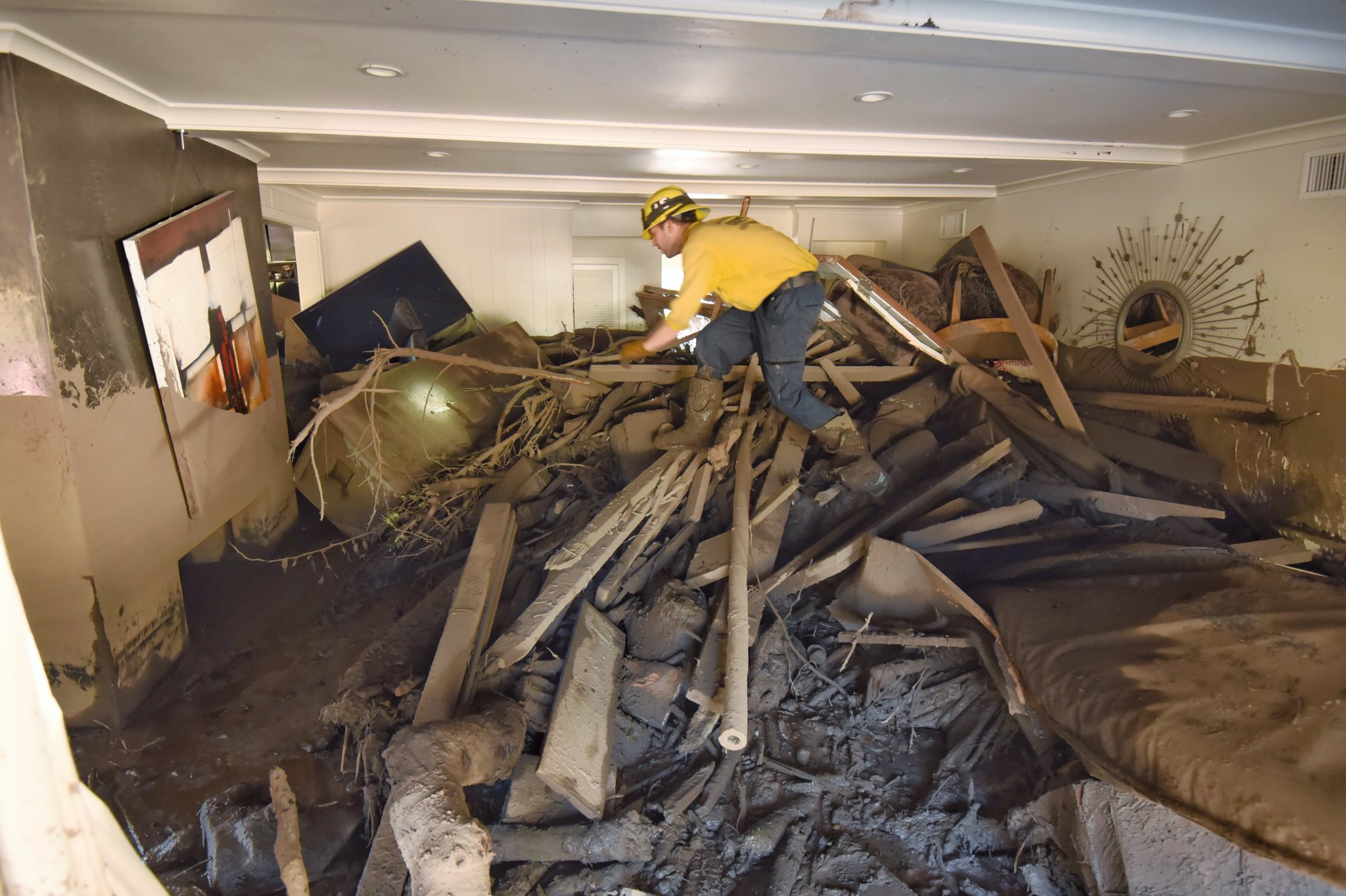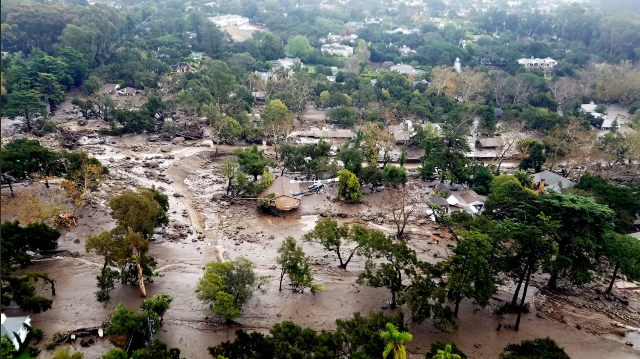Why Did So Few in Montecito Evacuate?
Communicating Danger Before, During Disasters Is a Delicate, Difficult Business

Before January 9, few Montecitans had any concept of the cataclysmic power of debris flows, their Southern California disaster lexicon limited mostly to wildfires and earthquakes. “If you’re a natural scientist and you hear ‘debris flow,’ you think, ‘Oh god, that could kill people,’” said Sue Perry, a disaster specialist with the United States Geological Survey. “But no one else around here knows what that term means.”
Perry, a Carpinteria resident, is part of of the federal agency’s Science Application for Risk Reduction project that studies how emergency planners and public officials can more effectively convey the dangers of imminent threats to life and limb. She was brought on in the aftermath of last week’s deadly storm to assess how successfully scientific information was understood and affected decisions. “There’s going to be a lot of scrutiny after this,” she said.
Santa Barbara’s Office of Emergency Management (OEM) kick-started its public information campaign during a January 5 press conference, where National Weather Service, Cal Fire, flood control, and Sheriff’s Office officials issued dire warnings to county residents about the ferocity of the upcoming rainstorm and its likely ability to send earth and water sweeping through neighborhoods below the Thomas Fire burn scar.
“We can’t stress enough the fact that this is a significant risk to our community,” said Public Works Deputy Director Tom Fayram. “The third area of concern is going to be people who live near water courses such as creeks,” said OEM Director Robert Lewin, after describing two other danger zones as within and immediately around burn scar tissue. “[Creeks] can become raging rivers of water and mud and rocks and debris, and if you live near one of those, you need to understand that.” Many people were killed when flows breached the walls of Montecito, San Ysidro, and Romero creeks.
Kevin Cooper, a biologist with the U.S. Forest Service, focused specifically on the peril of debris flows ― unstoppable avalanches of dislodged boulders and uprooted trees mixed with mud and water ― and advised residents to heed alerts if the weather turned especially nasty. “The alerts are going to be very important,” he said.

Debris flows of the size and scale that destroyed entire Montecito neighborhoods and killed 20 residents are so rare in general and so infrequent in Santa Barbara County that those in its path may have simply been unable to comprehend the risk, said Perry. Perhaps that’s why so few people within mandatory evacuation zones ― an estimated 15 to 20 percent ― actually left their homes. “Human nature is not set up to deal with rare events,” Perry explained. “Things that seem remote or are outside our experience are tough for us to wrap our heads around.”
The threats of mudslides and flash flooding were easier to understand and easier to plan for, she went on. “People make decisions on how to stay safe based on experience,” Perry said. “Maybe they thought, ‘Mudslides? Big deal. Things are going to get dirty.’ Or, ‘Flooding? Big deal. I’ll get a few sandbags.’”
Perry also factored in the evacuation fatigue experienced by those who’d been forced to flee their homes during the fire. “Even I tried to talk myself out of evacuating, and I know how dangerous debris flows are,” she said. “I can really relate to people who didn’t want to leave.”
Perry called the strikingly low evacuation figures “frustrating and discouraging” and said there must be some way to “improve messaging to raise those numbers.” The answer isn’t as simple as more warnings. That can elicit a “cry wolf” effect and make residents ignore future warnings. During the 2009 Station Fire in Los Angeles County, for example, some communities were ordered to evacuate as many as 20 times in six weeks. Every time an order was issued, Perry said, fewer people left. It was a miracle that the debris flow that eventually came didn’t kill anyone, she said.
Sometimes simply reframing disaster language can help convey the message. Before 2012’s Hurricane Sandy, Perry said, few people understood the term “storm surge,” a wall of water pushed from ocean to land by intense winds. After the hurricane, which killed 233 people, including many who refused to evacuate, she noticed authorities and journalists begin to use more detailed and vivid wording to describe the extreme weather event. “Debris flow” may be one of those terms, she said.
The Santa Barbara public may have benefited from seeing more photos or videos of debris flows, which are visually and sonically petrifying, as bus-sized boulders floating like toy boats gnash and crash down mountainsides. Then again, such depictions may be interpreted as scare tactics and ignored, Perry said. “People are so complicated. They’re just really difficult.”
Cara Cuite is a human ecologist at Rutgers University who heads a National Oceanic and Atmospheric Administration–sponsored project on best practices in storm communication. “You need to make people believe they’re at risk and take it seriously,” she said. Just as important, Cuite explained, is clearly communicating to people what action they should take to protect themselves. “Once you have their attention, tell them what to do,” she said. “Being told they’re at risk without telling them how to reduce that risk just triggers a stress response without action.”
At the press conference ahead of Tuesday’s storm, OEM Director Lewin told the public: “Unfortunately, unlike in the fire, where we could merely say to evacuate ahead of time, in this case, sometimes evacuation isn’t the best choice. Sometimes the best thing for people to do is to go to their neighbor’s home that’s on high ground to get out of harm’s way. Sometimes the best action is to merely shelter in place. And unfortunately this is something that each citizen, each resident is going to have to determine.”
Cell-phone alerts sent by the OEM in the days and hours leading up to Tuesday’s storm advised residents to “shelter in place or go to high ground.” An emergency communications specialist who wished to remain anonymous contacted the Santa Barbara Independent on Monday with concerns about the clarity of the county’s messaging. He called the alerts “confusing,” asking if “high ground” was meant to be interpreted as a higher point within a home or up a nearby hill. He also said the wording was such that the two options felt mutually exclusive, when in fact the safest option for many residents caught in debris flows was to both shelter in place and climb to a second floor, attic, or roof. (A full accounting of the notifications and alerts issued by OEM before and during the storm is attached to the bottom of this article.)
Cuite acknowledged the limitations of cell-phone alerts, including character counts and coverage areas. She also emphasized the tricky tap dance of crisis communication in general, of striking a balance between scaring people to act without paralyzing them or losing their trust if disaster doesn’t strike. “It’s really hard,” she said. “You want to instill enough fear to motivate people, but not so much they’re just overwhelmed and shut down. It’s a sweet spot in communication.” Cuite explained that because each disaster is different, involving different circumstances, populations, and so on, there is no definable average for how many people typically heed evacuation orders.
On January 5, four days before the storm, the County of Santa Barbara posted on its Facebook page a map of predicted flooding and debris flows, which covered large portions of Montecito. “My entire work zone that I return to on Monday,” wrote a commenter. “Scared!” The county replied: “We don’t want to scare anyone. Knowing the potential and being prepared is half the battle.”



